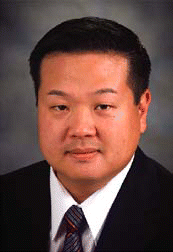After a follow-up of 19 months, median overall survival was 11 months and progression-free survival was six months. Our one-year survival, of note, is 48 percent, Dr. Kim said.
Explore This Issue
February 2008The study also found that 25 patients had recurrent disease in a prior irradiated field. Of these, three achieved a complete response (12%) and 11 patients (44%) had a partial response.
The most common grade 3/4 toxicity was neutropenia (64%), but only 10% of patients had febrile neutropenia. Another 14% of patients had anemia. Dehydration, nausea, vomiting, and skin toxicity were the most common nonhematologic toxicities.
This is the first study to report use of the EGFR tyrosine kinase inhibitor erlotinib combined with chemotherapy in incurable head and neck cancer, Dr. Kim said. There is encouraging efficacy, including a 66% response rate, 11-month median survival, six-month progression-free survival, and 48% one-year survival.
There is a proposed Phase II randomized study to compare docetaxel plus cisplatin versus docetaxel plus cisplatin and erlotinib, he said. We need to consider testing an active regimen such as this in chemo-naïve patients in the neoadjuvant or induction settings.
Cetuximab + Weekly Paclitaxel
In the second study, the combination of cetuximab and weekly paclitaxel was also well tolerated and provided encouraging activity in advanced/recurrent squamous cell carcinoma of the head and neck.
More than half of all newly diagnosed cases of squamous cell carcinoma of the head and neck are not cured and will relapse locally or at distant sites, noted Ricardo Hitt, MD, of the Medical Oncology Service at University Hospital 12 de Octubre in Madrid. Median survival is less than six months, and the survival rate has not changed in the past 20 years.
Cetuximab and paclitaxel have shown to be active in squamous cell carcinoma of the head and neck. Preclinical data have demonstrated a possible synergy for the combination. In a variety of tumor types, weekly paclitaxel has demonstrated an improved safety profile and activity as compared with a schedule of every three weeks paclitaxel, providing the rationale to study the combination of cetuximab and weekly paclitaxel in metastatic/recurrent squamous cell carcinoma of the head and neck.
To explore this combination as front-line treatment for this disease, the Spanish Head and Neck Group initiated a Phase II trial. Patients enrolled may have received one regimen of induction and/or concomitant chemotherapy, but not within the recurrent/metastatic setting. Treatment included weekly paclitaxel at 80 mg/m2 and cetuximab at an initial dose of 400 mg/m2, followed by a weekly infusion of 250 mg/m2.

Leave a Reply